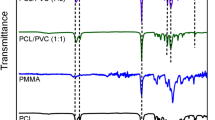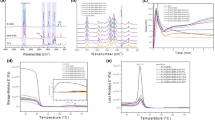Abstract
Like alloys in metallurgy, polymers are blended to obtain new characteristics, which is important to extend their application area. In this study, three different compositions of azide-functionalized poly(vinyl chloride)-PVC-N3 and poly(ε-caprolactone)-PCL were blended. Physical properties, such as mechanical and thermal behavior of the blends, were investigated through the tensile test, DSC, and TGA. Also, a blended polymer with equal participation of each constituent was trained to determine the shape memory behavior of the sample. The results showed that PVC-N3 and PCL were completely miscible; therefore, all physical properties are somewhere between the pure polymers. The blend with only 50% PCL, as an example, still kept its shape memory behavior; additionally, the blended polymers partially achieved crystalline behavior by adding PCL to the PVC-N3. The tensile test also showed that the modulus of toughness and other mechanical behavior depends on the compositional ratio of the polymers. Consequently, the miscibility of the PCL and PVC-N3 enhances the physical properties of both polymers as a function of composition.
Graphic abstract










Similar content being viewed by others
References
W. Huang, B. Yang, L. An, C. Li, Y. Chan, Water-driven programmable polyurethane shape memory polymer: demonstration and mechanism. Appl. Phys. Lett. 86(11), 114105 (2005). https://doi.org/10.1063/1.1880448
T. Xie, Tunable polymer multi-shape memory effect. Nature 464(7286), 267–270 (2010)
C. Liu, H. Qin, P. Mather, Review of progress in shape-memory polymers. J. Mater. Chem. 17(16), 1543–1558 (2007)
A. Lendlein, H. Jiang, O. Jünger, R. Langer, Light-induced shape-memory polymers. Nature 434(7035), 879–882 (2005). https://doi.org/10.1038/nature03496
H. Koerner, G. Price, N.A. Pearce, M. Alexander, R.A. Vaia, Remotely actuated polymer nanocomposites—stress-recovery of carbon-nanotube-filled thermoplastic elastomers. Nat. Mater. 3(2), 115–120 (2004)
T. Chung, A. Romo-Uribe, P.T. Mather, Two-way reversible shape memory in a semicrystalline network. Macromolecules 41(1), 184–192 (2008). https://doi.org/10.1021/ma071517z
W. Li, Y. Liu, J. Leng, Triple-shape memory effect of polystyrene based polymer blends. J. Mater. Chem. A 3(48), 24532 (2015)
J. Hu, Y. Zhu, H. Huang, J. Lu, Recent advances in shape–memory polymers: structure, mechanism, functionality, modeling and applications. Prog. Polym. Sci. 37(12), 1720–1763 (2012)
T. Xie, I.A. Rousseau, Facile tailoring of thermal transition temperatures of epoxy shape memory polymers. Polymer 50(8), 1852–1856 (2009)
Q. Meng, J. Hu, Y. Zhu, J. Lu, Y. Liu, Morphology, phase separation, thermal and mechanical property differences of shape memory fibres prepared by different spinning methods. Smart Mater. Struct. 16(4), 1192 (2007)
Q. Meng, J. Hu, L. Yeung, An electro-active shape memory fibre by incorporating multi-walled carbon nanotubes. Smart Mater. Struct. 16(3), 830 (2007)
A. Lendlein, R. Langer, Biodegradable, elastic shape-memory polymers for potential biomedical applications. Science 296(5573), 1673–1676 (2002)
I.H. Paik, N.S. Goo, Y.C. Jung, J.W. Cho, Development and application of conducting shape memory polyurethane actuators. Smart Mater. Struct. 15(5), 1476–1482 (2006). https://doi.org/10.1088/0964-1726/15/5/037
H. Jin Yoo, Y. Chae Jung, N. Gopal Sahoo, J. Whan Cho, Polyurethane-carbon nanotube nanocomposites prepared by in-situ polymerization with electroactive shape memory. J. Macromol. Sci. Part B 45(4), 441–451 (2006). https://doi.org/10.1080/00222340600767471
D.J. Maitland, M.F. Metzger, D. Schumann, A. Lee, T.S. Wilson, Photothermal properties of shape memory polymer micro-actuators for treating stroke*. Lasers Surg. Med. 30(1), 1–11 (2002). https://doi.org/10.1002/lsm.10007
W. Small Iv, T.S. Wilson, W.J. Benett, J.M. Loge, D.J. Maitland, Laser-activated shape memory polymer intravascular thrombectomy device. Opt. Express 13(20), 8204–8213 (2005). https://doi.org/10.1364/OPEX.13.008204
R. Mohr, K. Kratz, T. Weigel, M. Lucka-Gabor, M. Moneke, A. Lendlein, Initiation of shape-memory effect by inductive heating of magnetic nanoparticles in thermoplastic polymers. Proc. Natl. Acad. Sci. 103(10), 3540–3545 (2006)
A.M. Schmidt, Electromagnetic activation of shape memory polymer networks containing magnetic nanoparticles. Macromol. Rapid Commun. 27(14), 1168–1172 (2006). https://doi.org/10.1002/marc.200600225
Y. Chae Jung, H. Hwa So, J. Whan Cho, Water-responsive shape memory polyurethane block copolymer modified with polyhedral oligomeric silsesquioxane. J. Macromol. Sci. Part B 45(4), 453–546 (2006). https://doi.org/10.1080/00222340600767513
M. Behl, A. Lendlein, Shape-memory polymers. Mater. Today 10(4), 20–28 (2007). https://doi.org/10.1016/S1369-7021(07)70047-0
H. Qin, P.T. Mather, Combined one-way and two-way shape memory in a glass-forming nematic network. Macromolecules 42(1), 273–280 (2009). https://doi.org/10.1021/ma8022926
E. Themistou, C.S. Patrickios, Synthesis and characterization of polymer networks and star polymers containing a novel, hydrolyzable acetal-based dimethacrylate cross-linker. Macromolecules 39(1), 73–80 (2006). https://doi.org/10.1021/ma0513416
A.M. Abdelghany, M.S. Meikhail, N. Asker, Synthesis and structural-biological correlation of PVC\PVAc polymer blends. J. Market. Res. 8(5), 3908–3916 (2019). https://doi.org/10.1016/j.jmrt.2019.06.053
W. Liu, R. Zhang, M. Huang, X. Dong, W. Xu, N. Ray, J. Zhu, Design and structural study of a triple-shape memory PCL/PVC blend. Polymer 104, 115–122 (2016). https://doi.org/10.1016/j.polymer.2016.09.079
H. Haruna, M.E. Pekdemir, A. Tukur, M. Coşkun, Characterization, thermal and electrical properties of aminated PVC/oxidized MWCNT composites doped with nanographite. J. Therm. Anal. Calorim. 139(6), 3887–3895 (2020)
V.H. Mareau, R.E. Prud’Homme, Growth rates and morphologies of miscible PCL/PVC blend thin and thick films. Macromolecules 36(3), 675–684 (2003)
H.G. Kia, M.W. Verbrugge, T. Xie, I.A. Rousseau. Shape memory polymer containing composite materials. Google Patents; 2016.
J. Thornton, Environmental Impacts of Polyvinyl Chloride (PVC) Building Materials (Healthy Building Network, Washington, DC, 2002)
N. Asan, T. Öztürk, Synthesis and characterization of poly(vinyl chloride–graft–ethylene glycol) graft copolymers by “click” chemistry. Hacettepe J. Biol. Chem. 45(1), 35–42 (2017)
Y. Zhang, R.-X. Zhuo, Synthesis and in vitro drug release behavior of amphiphilic triblock copolymer nanoparticles based on poly(ethylene glycol) and polycaprolactone. Biomaterials 26(33), 6736–6742 (2005)
W.J. Jia, Y.C. Gu, M.L. Gou, M. Dai, X.Y. Li, B. Kan, J.L. Yang, Q.F. Song, Y.Q. Wei, Z.Y. Qian, Preparation of biodegradable polycaprolactone/poly(ethylene glycol)/polycaprolactone (PCEC) nanoparticles. Drug Deliv. 15(7), 409–416 (2008)
C.G. Pitt, T.A. Marks, A. Schindler, Biodegradable Drug Delivery Systems Based on Aliphatic Polyesters: Application to Contraceptives and Narcotic Antagonists (Academic Press, New York, 1980)
Q. Xu, X. Ren, Y. Chang, J. Wang, L. Yu, K. Dean, Generation of microcellular biodegradable polycaprolactone foams in supercritical carbon dioxide. J. Appl. Polym. Sci. 94(2), 593–597 (2004)
M.A. Woodruff, D.W. Hutmacher, The return of a forgotten polymer—polycaprolactone in the 21st century. Prog. Polym. Sci. 35(10), 1217–1256 (2010)
Q. Li, G. Li, S. Yu, Z. Zhang, F. Ma, Y. Feng, Ring-opening polymerization of ɛ-caprolactone catalyzed by a novel thermophilic lipase from Fervidobacterium nodosum. Process. Biochem. 46(1), 253–257 (2011)
J.W. Peeters, O. van Leeuwen, A.R. Palmans, E. Meijer, Lipase-catalyzed ring-opening polymerizations of 4-substituted ε-caprolactones: mechanistic considerations. Macromolecules 38(13), 5587–5592 (2005)
Z. Pingping, Y. Haiyang, W. Shiqiang, Viscosity behavior of poly-ϵ-caprolactone (PCL)/poly(vinyl chloride)(PVC) blends in various solvents. Eur. Polymer J. 34(1), 91–94 (1998)
R.M. Silverstein, G.C. Bassler, Spectrometric identification of organic compounds. J. Chem. Educ. 39(11), 546 (1962)
M. Kok, K. Demirelli, Y. Aydogdu, Thermophysical properties of blend of poly(vinyl chloride) with poly(isobornyl acrylate). Int. J. Sci. Technol. 3(1), 37–42 (2008)
P. Parashar, K. Ramakrishna, A. Ramaprasad, A study on compatibility of polymer blends of polystyrene/poly(4-vinylpyridine). J. Appl. Polym. Sci. 120(3), 1729–1735 (2011)
W. Brostow, R. Chiu, I.M. Kalogeras, A. Vassilikou-Dova, Prediction of glass transition temperatures: binary blends and copolymers. Mater. Lett. 62(17–18), 3152–3155 (2008)
R. Godehardt, S. Rudolph, W. Lebek, S. Goerlitz, R. Adhikari, E. Allert, J. Giesemann, G. Michler, Morphology and micromechanical behavior of blends of ethene/1-hexene copolymers. J. Macromol. Sci. Phys. 38(5–6), 817–835 (1999)
W.E. Baker, C.E. Scott, G.-H. Hu, M. Akkapeddi, Reactive Polymer Blending. Hanser Munich (2001).
I. Sakurada, Polyvinyl Alcohol Fibers. International Fiber Science and Technology Series 6 (CRC Press, New York, 1985)
Y. Xu, Y. Xiong, S. Guo, Effect of liquid plasticizers on crystallization of PCL in soft PVC/PCL/plasticizer blends. J. Appl. Polym. Sci. 137(24), 48803 (2020)
J. Feng, Z. Zhang, A. Bironeau, A. Guinault, G. Miquelard-Garnier, C. Sollogoub, A. Olah, E. Baer, Breakup behavior of nanolayers in polymeric multilayer systems—creation of nanosheets and nanodroplets. Polymer 143, 19–27 (2018)
X.-G. Li, B.-G. Ma, L. Xu, Z.-W. Hu, X.-G. Wang, Thermogravimetric analysis of the co-combustion of the blends with high ash coal and waste tyres. Thermochim. Acta 441(1), 79–83 (2006)
R.M. Aghdam, S. Najarian, S. Shakhesi, S. Khanlari, K. Shaabani, S. Sharifi, Investigating the effect of PGA on physical and mechanical properties of electrospun PCL/PGA blend nanofibers. J. Appl. Polym. Sci. 124(1), 123–131 (2012)
S.H. Ajili, N.G. Ebrahimi, M. Soleimani, Polyurethane/polycaprolactane blend with shape memory effect as a proposed material for cardiovascular implants. Acta Biomater. 5(5), 1519–1530 (2009)
K. Gall, C.M. Yakacki, Y. Liu, R. Shandas, N. Willett, K.S. Anseth, Thermomechanics of the shape memory effect in polymers for biomedical applications. J. Biomed. Mater. Res. Part A 73(3), 339–348 (2005)
R. Xiao, J. Guo, T.D. Nguyen, Modeling the multiple shape memory effect and temperature memory effect in amorphous polymers. RSC Adv. 5(1), 416–423 (2015)
H. Zhang, H. Wang, W. Zhong, Q. Du, A novel type of shape memory polymer blend and the shape memory mechanism. Polymer 50(6), 1596–1601 (2009). https://doi.org/10.1016/j.polymer.2009.01.011
P. Mohammadi, M.S. Toivonen, O. Ikkala, W. Wagermaier, M.B. Linder, Aligning cellulose nanofibril dispersions for tougher fibers. Sci. Rep. 7(1), 11860 (2017). https://doi.org/10.1038/s41598-017-12107-x
T. Niem, N. Youssef, B. Wöstmann, Energy dissipation capacities of CAD-CAM restorative materials: a comparative evaluation of resilience and toughness. J. Prosthet. Dent. 121(1), 101–109 (2019). https://doi.org/10.1016/j.prosdent.2018.05.003
S. Gautam, A.K. Dinda, N.C. Mishra, Fabrication and characterization of PCL/gelatin composite nanofibrous scaffold for tissue engineering applications by electrospinning method. Mater. Sci. Eng., C 33(3), 1228–1235 (2013)
S.M. Martins-Franchetti, T. Egerton, J. White, Morphological changes in poly(caprolactone)/poly(vinyl chloride) blends caused by biodegradation. J. Polym. Environ. 18(1), 79–83 (2010)
M. Amini, S. Wu, Designing a polymer blend nanocomposite with triple shape memory effects. Compos. Commun. 23, 100564 (2021)
Acknowledgements
This work was supported by the Management Unit of the Scientific Research Projects of Firat University (FUBAP) (Project Numbers: FF.20.14 and FF.20.06).
Author information
Authors and Affiliations
Corresponding author
Ethics declarations
Conflict of interest
The authors declare no conflict of interest.
Rights and permissions
About this article
Cite this article
Pekdemir, M.E., Qader, I.N., Öner, E. et al. Investigation of structure, mechanical, and shape memory behavior of thermally activated poly(ε-caprolactone): azide-functionalized poly(vinyl chloride) binary polymer blend films. Eur. Phys. J. Plus 136, 800 (2021). https://doi.org/10.1140/epjp/s13360-021-01802-4
Received:
Accepted:
Published:
DOI: https://doi.org/10.1140/epjp/s13360-021-01802-4




